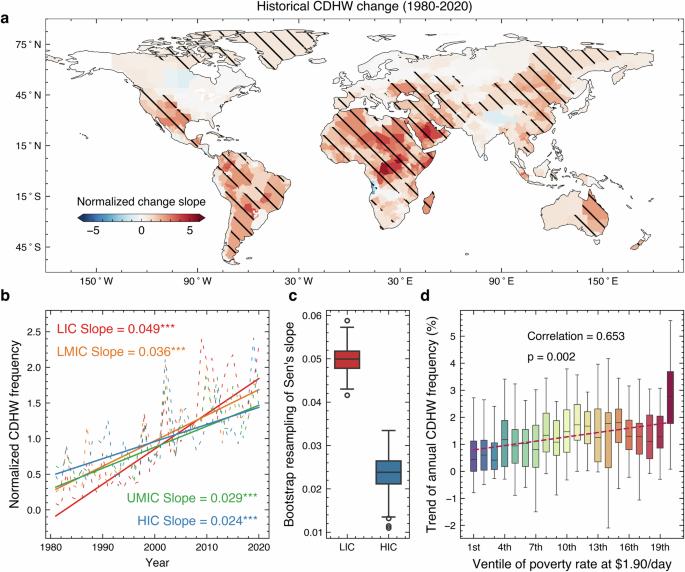人为气候变化使低收入地区的复合干旱和热浪频率增加了一倍
IF 8.1
1区 地球科学
Q1 ENVIRONMENTAL SCIENCES
引用次数: 0
摘要
复合干旱热浪因其灾难性后果而受到广泛关注。然而,很少有研究对气候变化下复合干旱热浪暴露的不平等现象进行调查。在这里,我们利用观测数据和气候模型揭示了低收入地区和高收入地区在全球复合干旱热浪发生率方面的显著差异。我们发现,从 1981 年到 2020 年,低收入地区的复合干旱热浪频率增加了 377% [351-403%],是高收入地区增加速度(184% [153-204%])的两倍。这种不平等主要归因于干旱发生率的类似差异,而非热浪发生率。气候变化归因表明,人为变暖使 31% [14-50%] 低收入地区的复合干旱-热浪频率增加了一倍,而高收入地区的复合干旱-热浪频率仅为 4.7% [0.9-8.3%]。如果没有人为气候变化,低收入地区的复合干旱热浪频率不会增加,但高收入地区的复合干旱热浪频率仍会上升。根据一项利用气候模型、干旱指数和人口数据进行的分析,从 1981 年到 2020 年,低收入地区的复合干旱热浪事件频率比高收入地区增加得更快,而这一增加归因于人为气候变化。本文章由计算机程序翻译,如有差异,请以英文原文为准。

Anthropogenic climate change doubled the frequency of compound drought and heatwaves in low-income regions
Compound drought-heatwaves have garnered widespread attention due to their catastrophic consequences. However, little research has investigated inequalities in exposure to compound drought-heatwaves under climate change. Here, we reveal a significant disparity between low-income and high-income regions in terms of global compound drought-heatwave occurrence using observations and climate models. We find that low-income regions experienced a 377% [351–403%] increase in the frequency of compound drought-heatwaves from 1981 to 2020, which is twice as fast as the increase observed in high-income regions (184% [153–204%]). This inequality is largely attributed to a similar disparity in drought occurrence rather than heatwave occurrence. Climate change attribution suggests that anthropogenic warming has doubled the frequency of compound drought-heatwaves over 31% [14–50%] of low-income regions, compared to only 4.7% [0.9–8.3%] of high-income regions. The frequency of compound drought-heatwaves would not have increased in low-income regions without anthropogenic climate change but would still have risen in high-income regions. From 1981 to 2020, low-income regions experienced a faster increase in the frequency of compound drought-heatwaves events than high-income regions, and the increase is attributed to anthropogenic climate change, according to an analysis that uses climate models, drought index, and population data
求助全文
通过发布文献求助,成功后即可免费获取论文全文。
去求助
来源期刊

Communications Earth & Environment
Earth and Planetary Sciences-General Earth and Planetary Sciences
CiteScore
8.60
自引率
2.50%
发文量
269
审稿时长
26 weeks
期刊介绍:
Communications Earth & Environment is an open access journal from Nature Portfolio publishing high-quality research, reviews and commentary in all areas of the Earth, environmental and planetary sciences. Research papers published by the journal represent significant advances that bring new insight to a specialized area in Earth science, planetary science or environmental science.
Communications Earth & Environment has a 2-year impact factor of 7.9 (2022 Journal Citation Reports®). Articles published in the journal in 2022 were downloaded 1,412,858 times. Median time from submission to the first editorial decision is 8 days.
 求助内容:
求助内容: 应助结果提醒方式:
应助结果提醒方式:


